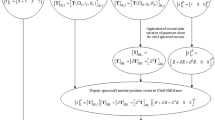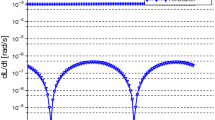Abstract
A new formulation of the orbital element-based relative motion equations is developed for general Keplerian orbits. This new solution is derived by performing a Taylor expansion on the Cartesian coordinates in the rotating frame with respect to the orbital elements. The resulted solution is expressed in terms of two different sets of orbital elements. The first one is the classical orbital elements and the second one is the nonsingular orbital elements. Among of them, however, the semi-latus rectum and true anomaly are used due to their generality, rather than the semi-major axis and mean anomaly that are used in most references. This specific selection for orbital elements yields a new solution that is universally applicable to elliptic, parabolic and hyperbolic orbits. It is shown that the new orbital element-based relative motion equations are equivalent to the Tschauner-Hempel equations. A linear map between the initial orbital element differences and the integration constants associated with the solution of the Tschauner-Hempel equations is constructed. Finally, the presented solution is validated through comparison with a high-fidelity numerical orbit propagator. The numerical results demonstrate that the new solution is computationally effective; and the result is able to match the accuracy that is required for linear propagation of spacecraft relative motion over a broad range of Keplerian orbits.
Similar content being viewed by others
Change history
11 February 2022
A Correction to this paper has been published: https://doi.org/10.1007/s42064-022-0136-2
References
Sullivan, J., Grimberg, S., D′Amico, S.Comprehensive survey and assessment of spacecraft relative motion dynamics models. Journal of Guidance, Control, and Dynamics, 2017, 40(8): 1837–1859.
Hill, G. W. Researches in the lunar theory, American Journal of Mathematics, 1878, 1(1): 5–26.
Clohessy, W. H., Wiltshire, R. S. Terminal guidance system for satellite rendezvous, Journal of the Aerospace Sciences, 1960, 27(9): 653–658.
Tschauner, J., Hempel, P. OptimaleBeschleunigungspro-gramme fur das Rendezvous-Manover. Astronautica Acta, 1964, 10(5-6): 296–307.
Lawden, D. F. Fundamentals of space navigation. Journal of the British Interplanetary Society, 1954, 13(2): 87–101.
Carter, T., Humi, M. Fuel-optimal rendezvous near apoint in general Keplerianorbit. Journal of Guidance, Control, and Dynamics, 1987, 10(6): 567–573.
Carter, T. New form for the optimal rendezvous equations near a Keplerian orbit. Journal of Guidance, Control, and Dynamics, 1990, 13(1): 183–186.
Carter, T. State transition matrices for terminal rendezvous studies: brief survey and new example. Journal of Guidance, Control, and Dynamics, 1998, 21(1): 148–155.
Yamanaka, K., Ankersen, F. New state transition matrix for relative motion on an arbitrary elliptical orbit. Journal of Guidance, Control, and Dynamics, 2002, 25(1): 60–66.
Dang, Z. Solutions of Tschauner-Hempel Equations. Journal of Guidance Control and Dynamics, 2017, 40(11): 2953–2957.
Sengupta, P., Vadali, S. Relative motion and the geometry of formations in Keplerianelliptic orbits with arbitrary eccentricity. Journal of Guidance, Control, and Dynamics, 2007, 30(4): 953–964.
Garrison, J. L., Gardner, T. G., Axelrad, P. Relative motion in highly elliptical orbits. Space ight Mechanics 1995, 1995: 1359–1376.
Alfriend, K. T., Gim, D. W., Schaub, H. Gravitational perturbations, nonlinearity and circular orbit assumption effects on formation flying control strategies. Guidance and Control 2000, 2000: 139–158.
Alfriend, K. T., Yan, H. Orbital elements approach to the nonlinear formation flying problem. International Formation Flying Symposium, Toulouse, France. 2002.
Gim, D.-W., Alfriend, K. State Transition matrix of relative motion for the perturbed noncircular reference orbit. Journal of Guidance, Control, and Dynamics, 2003, 26(6): 956–971.
Schaub, H., Alfriend, K. Hybrid Cartesian and orbit element feedback law for formation flying spacecraft. Journal of Guidance, Control, and Dynamics, 2002, 25(2): 387–393.
Roscoe, C. T., Westphal, J. J., Griesbach, J. D., Hanspeter, S. Formation establishment and recon-flguration using differential elements in J2-perturbed orbits. Journal of Guidance, Control, and Dynamics, 2015, 38(9): 1725–1740.
Schaub, H. Relative orbit geometry through classical orbit element differences. Journal of Guidance, Control, and Dynamics, 2004, 27(5): 839–848.
Lane, C., Axelrad, P. Formation design in eccentric orbits using linearized equations of relative motion. Journal of Guidance, Control, and Dynamics, 2006, 29(1): 146–160.
Broucke, R. Solution of the elliptic rendezvous problem with the time as independent variable. Journal of Guidance, Control, and Dynamics, 2003, 26(4): 615–621.
Sinclair, A., Sherrill, R., Alan Lovell, T. Calibration of linearized solutions for satellite relative motion. Journal of Guidance, Control, and Dynamics, 2014, 37(4): 1362–1367.
Jiang, F., Li, J., Baoyin, H. Approximate analysis for relative motion of satellite formation flying in elliptical orbits. Celestial Mechanics and Dynamical Astronomy, 2007, 98(1): 31–66.
Vadali, S., Yan, H., Alfriend, K. Formation maintenance and fuel balancing for satellites with impulsive control. AIAA/AAS Astrodynamics Specialist Conference and Exhibit, Guidance, Navigation, and Control and Co-located Conference, 2008, AIAA 2008–7359.
Alfriend, K., Vadali, S. R., Gurfil, P. How, J., Breger, L. Spacecraft formation flying: dynamics, control and navigation. Elsevier, 2009.
Dang, Z. New state transition matrix for relative motion on an arbitrary Keplerianorbit. Journal of Guidance, Control, and Dynamics, 2017, 40(11): 2917–2927.
Acknowledgements
This work was supported by the National Natural Science Foundation of China (Grant No. 61403416) and the “The Hundred Talents Program” of Chinese Academy of Science.
Author information
Authors and Affiliations
Corresponding author
Additional information
Zhaohui Dang received his B.S. and Ph.D. degrees in aerospace engineering from National University of Defense Technology, China, in 2009 and 2015, respectively. Currently, he is a cooperated research fellow at Northwestern Polytechnical University. His area of expertise is in spacecraft relative motion modeling, controller design for spacecraft formation flying, and distributed space system simulation.
Hao Zhang received his B.S. and Ph.D. degrees in aerospace engineering from Beihang University, China, in 2006 and 2012, respectively. From 2012 to 2017, he was with Asher Space Research Institute in the Technion (Israel Institute of Technology), where he was a postdoctoral fellow. He is currently an associate research fellow in the Technology and Engineering Center for Space Utilization, Chinese Academy of Sciences. His research interests include distributed space systems, astrodynamics, and GN&C.
Rights and permissions
About this article
Cite this article
Dang, Z., Zhang, H. Linearized relative motion equations through orbital element differences for general Keplerian orbits. Astrodyn 2, 201–215 (2018). https://doi.org/10.1007/s42064-018-0021-1
Received:
Accepted:
Published:
Issue Date:
DOI: https://doi.org/10.1007/s42064-018-0021-1




